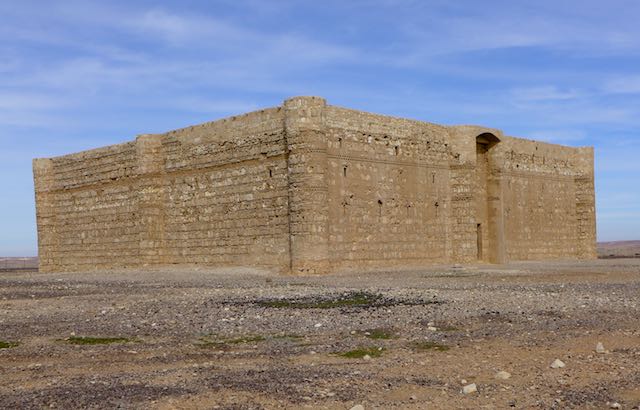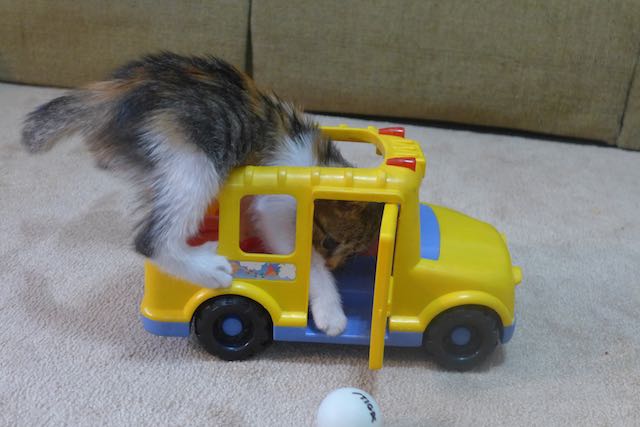Ever since arriving in Jordan, I have been hearing people talk about exploring the "Desert Castles" loop. When I checked it out, it looked fabulous, but far more than our family of littles (with potty breaks, diaper needs, snack demands and nap requirements) could handle in a day. So we've been breaking it up and hitting them at a more toddler-friendly pace.
We've now visited three of the northern/eastern castles in simple little day trips that just last a few hours. However, if you're not constricted with toddler-needs, then you can definitely do all in a day, but you won’t have the fun of countless roadside potty breaks in the Jordanian countryside.
Our first trip was out to Hallabat (Hallibat) Castle (coordinates: 32°05′34.4″N 36°19′40.8″E), located between Zarqa and Azraq, to the northeast of Amman. The drive out was uneventful, passing through little villages and towns. And then suddenly we were there; and it was just us and the guards. So we did a diaper check, got everyone their fill of crackers, and gathered them up and made the little trek over to the "castle".
In truth, none of the "Desert Castles" are actually castles. Some were hunting lodges, some were caravanserai (think travelers lodge and market), some farmhouses; all dating from around the seventh century Umayyad era. However, as they were being re-discovered in the nineteenth century, archeologists called them "castles" and the term has stuck. But true castle or not, they're worth the effort for weekend explorations.
The history of Hallabat can be traced back to remains uncovered of a second century Roman fort, on top of which was built a country palace in the sixth century, complete with mosaic floors (some of which you can still see today), a chapel and even a monastery. These were built using black basalt, in contrast to the white limestone used during continued renovations in the seventh century.
The site has undergone significant restoration from a Spanish archeological team; and their cranes and vehicles can be seen from miles away. Despite one guidebook’s claims that it's one of the "most elaborate [and]... most satisfying" castles to explore, I felt it was one of the smaller sites. But it does have an amazing view of the landscape, and part of the mosaic floor dating from 700AD can easily be seen, plus it's a place for the kids to run around. And since there's never anyone else visiting these sites, after your explorations, you can have a nice leisurely parking lot picnic with falafel sandwiches from Al Osrah (or your restaurant of choice). And as a bonus, we saw a lovely lizard sunning himself on the basalt stones, which is always a delight for everyone.
The guidebook also mentions a bathhouse just down the road. We ventured the 3km and found a structure in rubble surrounded by a fence. Being that there was no sign, we can't be certain this was the Umayyad "Hammam As-Srah" but we didn't see anything else remotely close.
Next on our toddler-timed explorations, we headed out east on Highway 40, towards Azraq, and checked out Amra Castle (coordinates: 31°48'10"N 36°35'19"E) and Kharana Castle (coordinates: 31°43'36" 036°27'48).
Definitely note, that these two are practically within eyesight of each other, so combining them seems logical. And we'll just skip the part about how we failed to do that on our first trip.
Amra (Qusayr Amra), while small, is listed on the World Heritage Site List for its intact colorful frescos decorating the walls. It's just 15km past Kharana on the opposite side.
Originally a hunting lodge and bathhouse from the early 700s, the evidence of which can be seen in the large reconstructed water wheel outside, the most amazing part is that the detailed frescos depicting naked women, cupids, animals, fruits and vines, survived despite an edict ordering the destruction of all human images only five years after its creation. Definitely check out all the nooks and crannies here, my favorite was the guitar-playing bear.
Keep in mind, that from the highway, Castle Kharana looks like a large 3-story stone cube. But if you turn in on the small road just past it, where the sign may or may not be visible, it will lead you to the visitors center. A few things to note about these visitor centers, they're always staffed, most sites are free, sometimes there's an open museum worth seeing, and typically there are adequate bathroom facilities.
Maybe it's the toddler influence, but Kharana was fun for its layout of rooms leading to more rooms.
Its second floor was worthy of exploration, too, with fleur-de-lis decorations still visible in the arches and arrow slits peeking out into the desert in all directions. It’s believed to date back to the late seventh century, with some graffiti dating to November 710AD found in an upper room. Its purpose was probably as a neutral meeting place for the Umayyad regime and local Bedouins, despite some appearances that it might have been an actual castle.
There are three more castles listed on the "loop", and according to the guidebook, Castle Mushatta is unfinished, and its most interesting find was the intricate carvings that were pried off and given to the Pergamon Museum in Berlin before World War I. There are also Castles Tuba and Burqu, both of which need to be accessed with a 4x4 and a desert guide. So, based on those tidbits, we may have completed enough of the Desert Castle loop to satisfy our curiosity.
Are any of these make-or-break sites in Jordan? No, but they're fun destinations outside of the city and a chance to soak up a little history and have a great parking lot picnic on a gorgeous weekend afternoon (with a smattering of scenic Jordanian countryside potty breaks). What more could you ask for?














































